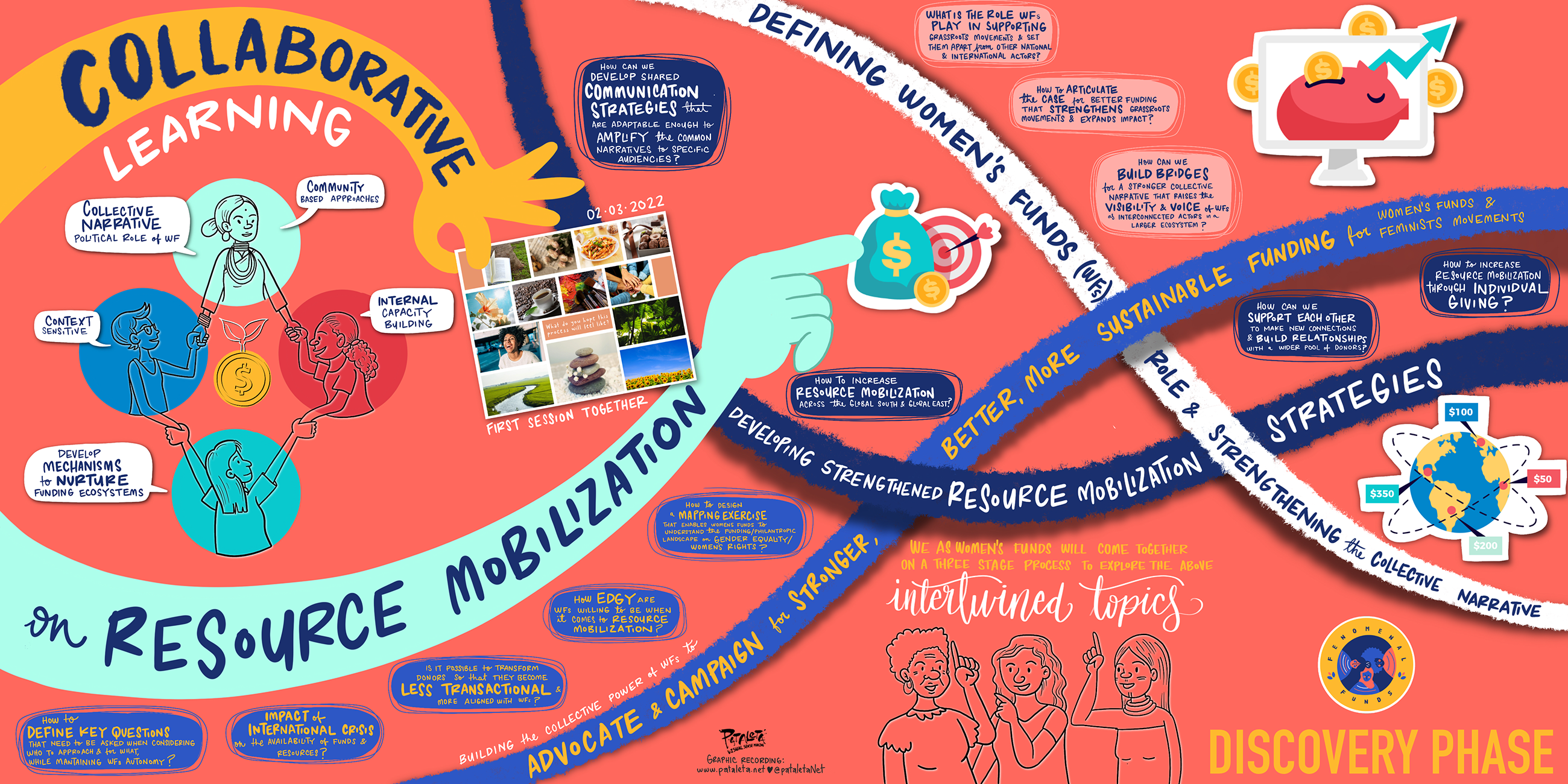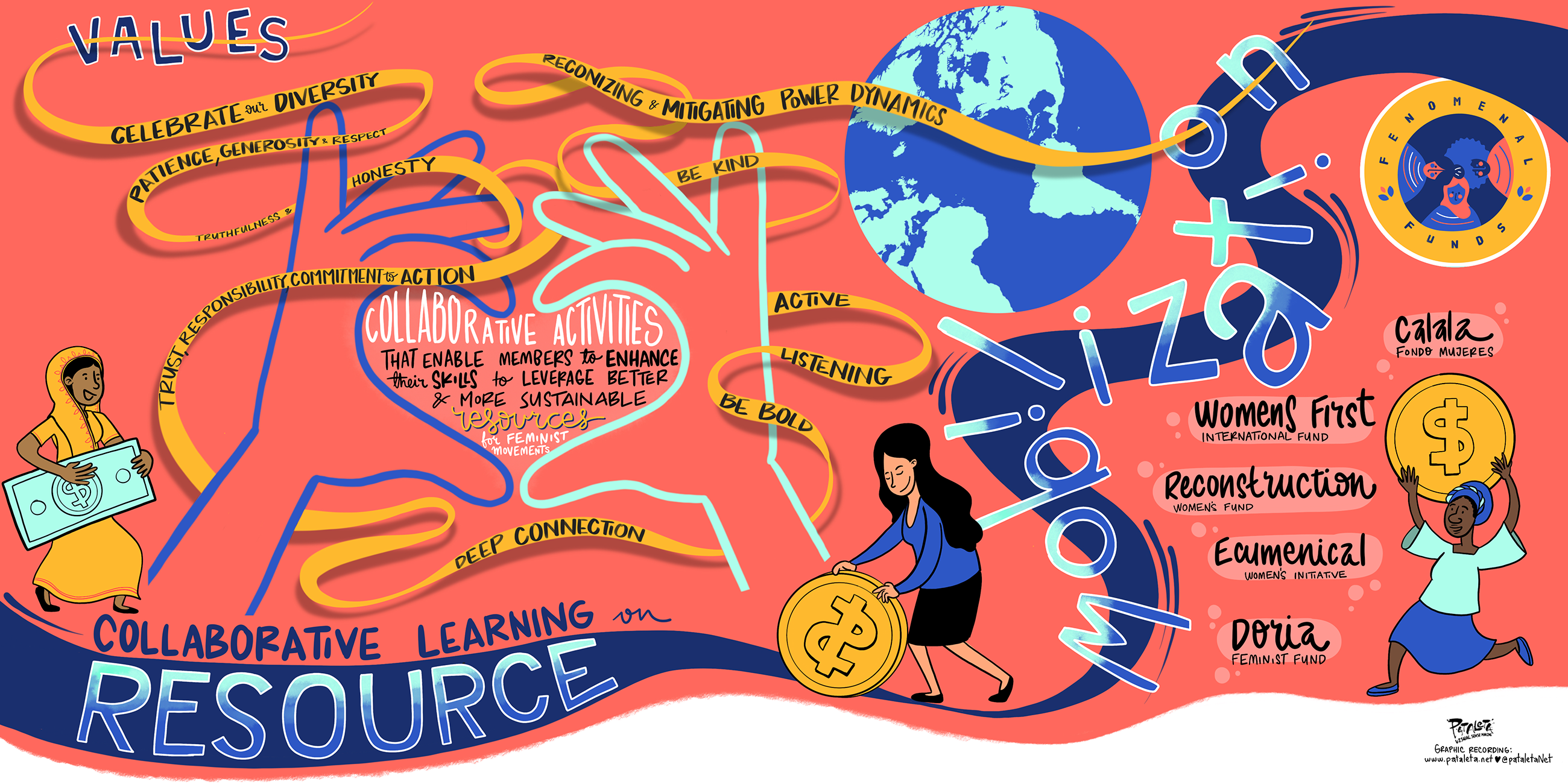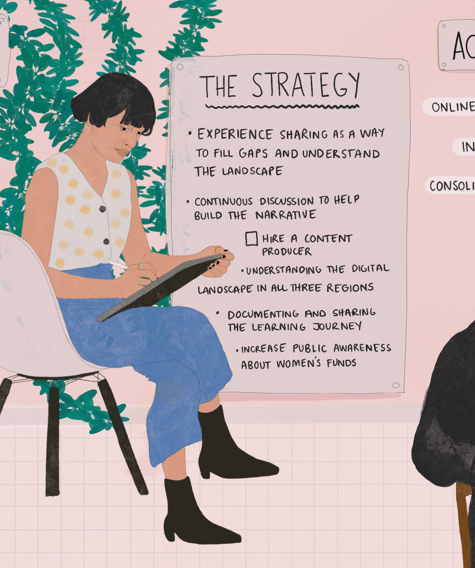In a competitive environment, how can women’s funds learn and strategize together to drive more and better funds to feminist movements, including in challenging political settings? This question is at the heart of two collaborations supported by Fenomenal Funds. In this blog post, drawing on mid-project reflections, we explore some of the women’s funds’ progress and emerging insights. Check back with us in March 2025 to learn more about their final reflections.
Jump to
Two Pathways to the Same Destination…
The Discover, Define, and Refine processes enabled Fenomenal Funds to support two distinct inquiries into resource mobilization.
…One Path Explores Collaborative Learning and Strategizing in the Context of Individual Giving and Corporate Fundraising…
The Collaborative Learning on Resource Mobilization (CLRM) brings together five women’s funds to:
- strengthen resource mobilization strategies,
- deepen the narrative about the political role of women’s funds in mobilizing better funding for grassroots women’s movements, and
- advocate and campaign for stronger, better, and more sustainable funding for women’s funds and feminist movements.
Developing a clear values proposition was key to finding commonality across the diverse national, regional, and global geographies of the six funds: Calala Fondo de Mujeres, Women First International Fund, Reconstruction Women’s Fund, Ecumenical Women’s Initiative, ELAS+, and Doria Feminist Fund (see Figure 1). While these funds vary in scope and size, they identified shared values and areas for learning that have supported the evolution of the collaboration (see Figure 2).


The initial work focused on a landscape analysis of resource mobilization opportunities and practices, leading to the development of a training curriculum and toolkit to build skills, confidence, and networks among women’s funds as they mobilize resources with corporate funders—in a way that is consistent with feminist values.
…Another Explores How to Mobilize Resources in Difficult Contexts.
The other collaboration brings together three diverse funds and explores the tools necessary to develop narratives and cases for investment in political contexts that are quite restrictive. Grounded in learning about each other’s contexts and approaches, the collaboration aims to produce digital content, relevant to each context, that will increase public awareness of the work and significance of women’s funds and build the capacity to mobilize resources in restrictive political contexts (see Figure 3).

The collaborations’ activities have tremendous potential to strengthen the financial resilience of women’s funds—with the end goal of supporting feminist movements and enhancing the role of women’s funds in the feminist funding ecosystem.
They Might Be on Two Pathways…but There are Commonalities
While each collaborative project has focused on specific aspects of resource mobilization, some commonalities around their processes have emerged:
- There is power in listening—in learning from each other and appreciating the common ground of hard work among women’s funds.
- Slowing down to enable fruitful reflections and insights to emerge was key, along with the flexibility to adjust timelines and plans as insights evolved and external pressures hampered original plans.
- Relationships are vital—and relationships built initially in face-to-face meetings of the funds enhanced communication and trust between them. The funds reflected that this turbo-powered their insights: they were able to create knowledge faster together compared to what they would have achieved individually.
- Clarity about an organization’s identity is critical to developing narratives that engage potential funders.
- Integrating a resource justice analysis—rethinking equitable resource distribution—was also seen to be important.
- And finally, collaboration takes you further, but context is key. Working as a community builds collective knowledge, but tailored approaches are imperative, particularly when targeting corporate partners.
While it is early days, the funds perceived that these practices are driving opportunities to shape powerful narratives articulating the unique role of women’s funds in the funding ecosystem.
Emerging Insights: The Importance of Language
Getting the language right is critical to successful resource mobilization. Beyond cultural and geographic languages, women’s funds and corporations use different languages. The idea of a shared narrative was challenging to develop, and women’s funds’ existing ways of describing their work did not always resonate with corporate partners. The women’s funds took time together to define a shared narrative to support their future work. They also adjusted their external messaging to ensure that sector jargon did not get in the way of effective communications with potential new public, corporate, or philanthropic partners. This involves managing the tension of making communications accessible to a broader audience while also not minimizing or invisibilizing the political agenda and role of women’s funds.
Emerging Insights into Corporate Resource Mobilization
While key deliverables still lie ahead, the landscape analysis points to these insights:
- Language barriers must be addressed when moving into corporate resource mobilization work.
- Building up an analysis of different corporate contexts is critical—they vary greatly by region and industry.
- Developing relationships of trust and exploring power dynamics required effort, in particular, to unpack tensions around collaborative decision-making and organizational autonomy within partnerships.
- Investing time into joint strategizing is important.
- Fostering trust and solidarity between the women’s funds was a necessary precursor to being able to explore the challenges of building or maintaining corporate relationships.
While the work of building corporate resource mobilization can be slow-paced, participants have reported that the collaborations have strengthened their capacity for resource mobilization and have the potential to unlock new, better resources for advancing women’s funds’ visions.
Check back with us in March 2025 to gain more details about the tools and practices of the funds evolving through the collaboration.

